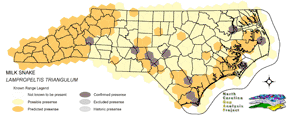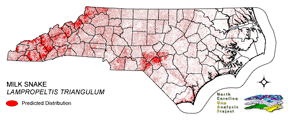
| Taxa: |
| Order: |
| Family: |
| Reptilia |
| Squamata |
| Colubridae |
| NatureServe Global Rank: |
| NatureServe State (NC) Rank: |
| G5 |
| S4 |
| Federal Status: |
| NC State Status: |
| --- |
| --- |


| Land Unit |
| US Fish & Wildlife Service |
| US Forest Service |
| US National Park Service |
| US Department of Defense |
| NC State Parks |
| NC University System |
| NC Wildlife Res. Com. |
| NC Forest Service |
| NC Div. of Coastal Mgmt. |
| Local Governments |
| Non-Governmental Org. |
| Other Public Lands |
| Private Lands |
| GAP Status 1-2 |
| All Protected Lands |
| Statewide |
| Hectares |
| 1,505.70 |
| 201,047.13 |
| 55,309.77 |
| 72,551.07 |
| 8,226.99 |
| 771.21 |
| 28,917.45 |
| 4,253.73 |
| 9.81 |
| 5,383.80 |
| 6,488.10 |
| 636.21 |
| 2,155,406.76 |
| 118,931.19 |
| 383,800.38 |
| 2,540,507.73 |
| Acres |
| 3,720.67 |
| 496,798.18 |
| 136,673.39 |
| 179,277.56 |
| 20,329.33 |
| 1,905.70 |
| 71,456.56 |
| 11,651.93 |
| 24.24 |
| 13,303.66 |
| 16,032.44 |
| 1,572.11 |
| 5,326,125.06 |
| 295,026.05 |
| 949,531.95 |
| 6,278,870.83 |
| % of Dist. on |
| Prot. Lands |
| 0.4 % |
| 52.4 % |
| 14.4 % |
| 18.9 % |
| 2.1 % |
| 0.2 % |
| 7.4 % |
| 1.1 % |
| < 0.1 % |
| 1.6 % |
| 1.6 % |
| < 0.1 % |
| < 0.1 % |
| 31.0 % |
| ----- |
| ----- |
| % of Dist. on |
| All Lands |
| < 0.1 % |
| 7.9 % |
| 2.2 % |
| 2.9 % |
| 0.3 % |
| < 0.1 % |
| 1.1 % |
| 0.2 % |
| < 0.1 % |
| 0.2 % |
| 0.3 % |
| < 0.1 % |
| 84.8 % |
| 4.7 % |
| ----- |
| ----- |
|
Coastal plain habitat includes Coastal Plain flatwoods dominated by loblolly or longleaf pines and wiregrass (Palmer and Braswell, 1995). NATURE SERVE GLOBAL HABITAT COMMENTS: Habitats diverse; semiarid to damp, lowlands to mountains, grasslands to open forests and forest edges, wilderness to suburban. Secretive; hides in logs and stumps and under surface cover. Sometimes found in the open. Hibernates underground or in rock crevice. Eggs are laid in soil, sawdust piles, under surface cover. |
| Code | Name | Description | NC Natural Heritage Program Equivalent |
| 97 | Mesic Longleaf Pine | Longleaf pine woodlands without a major scrub oak component. Slash or loblolly pines may be present as well. | Mesic Pine Flatwoods |
| 42 | Xeric Longleaf Pine | Sandhills including a range of longleaf pine density from predominantly wiregrass, scrub oak dominated to true longleaf pine woodland. This does not include mesic or saturated flatwood types. | Xeric Sandhill Scrub, Pine/Scrub Oak Sandhill, Coastal Fringe Sandhill |
| 46 | Xeric Oak - Pine Forests | Mixed forest dominated by yellow pines with white or northern red oaks co-dominating. | Pine Oak Heath |
| 232 | Xeric Pine-Hardwood Woodlands and Forests | Mixed forest dominated by yellow pines with drier oaks including southern red, post, and chestnut oaks. | Dry Oak Hickory Forest |
| 220 | Piedmont Xeric Pine Forests | Dry to xeric pine forests dominated by Virginia pine, shortleaf pine or Eastern Red Cedar. | Pine Oak Heath |
| 226 | Piedmont Xeric Woodlands | Generally post and blackjack oak dominated woodlands. White ash and pignut hickory can be found in combination with Eastern red cedar on glades. | Xeric Hardpan Forest |
| 205 | Agricultural Pasture/Hay and Natural Herbaceous | Farm fields used for pasture grass or hay production, as well as old fields dominated by native and exotic grasses. | No equivalent |
| 517 | Hemlock Floodplain Forest | Alluvial forest with hemlock and/or white pine in mountains and western piedmont. Hydrology is generally temporarily to seasonally flooded. | Canada Hemlock Forest |
| 522 | Northern Hardwoods | High Elevation forests including yellow birch, American beech, and yellow buckeye. Includes forests with Hemlock and Yellow Birch. | Northern Hardwoods Forest, Boulderfield Forest |
| 523 | Grassy Bald | High Elevation grassy balds including Pennsylvania sedge, mountain oatgrass, as well as shrubby areas dominated by Alleghany and smooth blackberry. | Grassy Bald |
| 524 | Shrub Bald | Variable phenologies, predominantly evergreen balds with rhododendon and Mountain laurels. Deciduous shrubs including green alder and Alleghany and smooth blackberry are included as well. Red Oak - Chestnut Oak Woodlands may be included in cases where the density of the woodland species is low and the shrub component is dense. | Heath Bald |
| 525 | Appalachian Oak Forest | A variety of oak forest types including Black, White, Scarlet Oaks in dry to mesic situations. Includes forests historically co-dominated by American Chestnut. | High Elevation Red Oak Forest, Montane White Oak Forest |
| 526 | Appalachian Cove Forest | Mixed Mesophytic forests of the mountains. Includes tuliptree, basswood, yellow buckeye and surgar maple. This class is mapped to include cove forests dominated or co-dominated by hemlock. | Rich Cove Forest, Acidic Cove Forest |
| 527 | Appalachian Hemlock | Upland hemlock forests of the moutains region. Vary from side slopes to steep slope positions. | Canada Hemlock Forest |
| 528 | Appalachian Xeric Pine Forest | Pine forests and woodlands on xeric sites. A variety of pines, including Virginia, Shortleaf, Eastern White Pine, Table Mountain and Pitch pine. Often small areas of dense pine within a matrix of Xeric Oak-Pine Forests. | Pine Oak Heath |
| 529 | Appalachian Xeric Mixed Forest | Mixed forests with Virginia, Shortleaf, Eastern White Pine, Table Mountain and Pitch pines in combination with xeric oak species. Oaks include, white, Southern Red, black, and rock chestnut. | Pine Oak Heath |
| 533 | Appalachian Swamp Forest | Evergreen and deciduous forests with saturated hydrologies. This class may contain a variety of trees species, including hemlock - red maple, pitch pine, and white pine forests. | Swamp Forest-Bog Complex, Southern Appalachian Bog, Southern Appalachian Fen |
| 535 | Talus/Outcrops/Cliffs | Includes seep talus slopes with sparce vegetation, as well as outcrops including, granitic outcrops. Some outcrops will have been mapped as barren rock. | No equivalent |
|
Dowling, H. G. 1993. Viewpoint:a reply to Collins (1991, 1992). Herpetol. Rev. 24:11-13.
Minton, S. A., Jr. 1972. Amphibians and reptiles of Indiana. Indiana Academy Science Monographs 3. v + 346 pp. Williams, K. L. 1978. Systematics and natural history of the American milk snake, Lampropeltis triangulum. Milwaukee Pub. Mus. Pub. Biol. & Geol. 2:1-258. Vogt, R. G. 1981. Natural history of amphibians and reptiles of Wisconsin. Milwaukee Public Museum. 205 pp. Collins, J. T. 1982. Amphibians and reptiles in Kansas. Second edition. Univ. Kansas Mus. Nat. Hist., Pub. Ed. Ser. 8. xiii + 356 pp. DeGraaf, R. M., and D. D. Rudis. 1983. Amphibians and reptiles of New England. Habitats and natural history. Univ. Massachusetts Press. vii + 83 pp. Tennant, A. 1984. The Snakes of Texas. Texas Monthly Press, Austin, Texas. 561 pp. Stebbins, R. C. 1985. A Field Guide to Western Reptiles and Amphibians. Second Edition. Houghton Mifflin Company, Boston, Massachusetts. xiv + 336 pp. Green, N. B., and T. K. Pauley. 1987. Amphibians and reptiles in West Virginia. University of Pittsburg Press, Pittsburg, Pennsylvania. xi + 241 pp. Collins, J. T. 1991. Viewpoint:a new taxonomic arrangement for some North American amphibians and reptiles. SSAR Herpetol. Review 22:42-43. |
For more information please contact them at:
NC-GAP Analysis Project
Dept. of Zoology, NCSU
Campus Box 7617
Raleigh, NC 27695-7617
(919) 513-2853
www.basic.ncsu.edu/ncgap